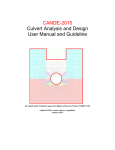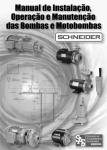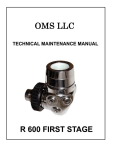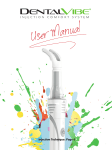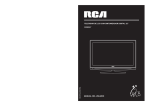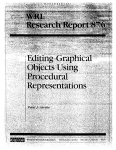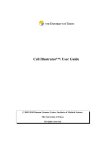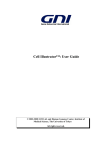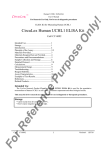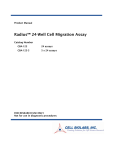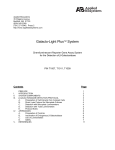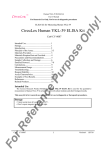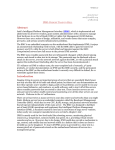Download CY-8096 Human Hsp27 ELISA Kit
Transcript
Human Hsp27 ELISA Kit User’s Manual For Research Use Only, Not for use in diagnostic procedures ELISA Kit for Measuring Human Hsp27 On ly! CircuLex TM CircuLex Human Hsp27 ELISA Kit ce Pu rp Intended Use................................................ 1 Storage......................................................... 1 Introduction.................................................. 2 Principle of the Assay.................................. 2-3 Materials Provided....................................... 3 Materials Required but not Provided........... 4 Precautions and Recommendations.............. 5 Sample Collection and Storage.................... 6 Detailed Protocol.......................................... 7-8 Calculations..................................…............ 9 Measurement Range..................................... 9 Troubleshooting............................................ 10 Reagent Stability.......................................... 10 Sample Preparation...................................... 11-12 Assay Characteristics................................... 13-15 Example of Test Results............................... 16-17 References.................................................... 18-19 Related Products........................................... 19 os e Cat# CY-8096 Intended Use The CycLex Research Product CircuLex Human Hsp27 ELISA Kit is used for the quantitative measurement of human Hsp27 in cell lysate, human serum and other biological media. en This assay kit is for research use only and not for use in diagnostic or therapeutic procedures. Storage rR ef er • Upon receipt store all components at 4°C. • Don’t expose reagents to excessive light. Fo Cat#: CY-8096 1 Version#: 140530 Human Hsp27 ELISA Kit User’s Manual For Research Use Only, Not for use in diagnostic procedures On ly! CircuLex TM Introduction Pu rp os e Hsp27 is an abundant and ubiquitous family of small HSP (heat shock protein) that acts as an ATP-independent chaperone and mainly localized in the cytosol (1). Small HSPs are potent mediator of protein folding and also involved in architecture of cytoskeleton, cell migration, cell growth/differentiation, and tumor progression (2-5). Hsp27 is also involved in the apoptotic signaling pathway because it interferes with the activation of cytochrome c/Apaf-1/dATP complex, thereby inhibiting the activation of procaspase-9 (6). The basic structure of most small HSPs is a homologous and highly conserved amino acid sequence, with an alpha-crystallin-domain at the C-terminus and the WD/EPF domain at the N-terminus. Hsp27 exists as both large oligomers that are proposed to have chaperone-like activity and as smaller oligomers that bind and cap barbed end microfilaments and stabilize them (7). The up-regulation of Hsp27 correlates with the rate of phosphorylation and with an increase of large oligomers. High levels of Hsp27 have been observed in many cancer cells including breast carcinoma (8, 9), ovarian cancer (10) and rectal cancer (11), compared to normal cells in which expression is undetectable or relatively low (2). Hsp27 is expressed constitutively in many tissues and its expression is increased to high levels after various types of stress including elevated temperatures, toxic metals, drugs and oxidants (12). Hsp27 can redistribute to the nucleus from the cytoplasm in response to stress, where it may function to stabilize DNA and/or the nuclear membrane. Hsp27 was reported to be associated with poor prognosis in gastric, liver, and prostate carcinoma and osteosarcomas (13, 14). However, other study showed that Hsp27 was not detectable in metastatic tumors and could be found only in samples derived from non-metastatic tumors (15). It was reported that the concentration of Hsp27 in serum from pancreatic tumor patients was found to be significantly higher than in serum from healthy controls (16) Principle of the Assay rR ef er en ce The CycLex Research Product CircuLex Human Hsp27 ELISA Kit employs the quantitative sandwich enzyme immunoassay technique. An antibody specific for human Hsp27 is pre-coated onto a microplate. Standards and samples are pipetted into the wells and the immobilized antibody binds any human Hsp27 present. After washing away any unbound substances, an HRP conjugated antibody specific for human Hsp27 is added to the wells. Following a wash to remove any unbound antibody HRP conjugate, the remaining conjugate is allowed to react with the substrate H2O2-tetramethylbenzidine. The reaction is stopped by addition of acidic solution and absorbance of the resulting yellow product is measured at 450 nm. The absorbance is proportional to the concentration of human Hsp27. A standard curve is constructed by plotting absorbance values versus human Hsp27 concentrations of calibrators, and concentrations of unknown samples are determined using this standard curve. Fo Cat#: CY-8096 2 Version#: 140530 Human Hsp27 ELISA Kit User’s Manual For Research Use Only, Not for use in diagnostic procedures Summary of Procedure Add 100 µL of diluted samples to the wells Incubate for 1 hour at room temp. Wash the wells On ly! CircuLex TM Add 100 µL of HRP conjugated anti-human Hsp27 antibody Wash the wells Add 100 µL of Substrate Reagent Pu rp Add 100 µL of Stop Solution os e Incubate for 1 hour at room temp. Measure absorbance at 450 nm Materials Provided All samples and standards should be assayed in duplicate. The following components are supplied and are sufficient for the one 96-well microplate kit. ce Microplate: One microplate supplied ready to use, with 96 wells (12 strips of 8-wells) in a foil, zip-lock bag with a desiccant pack. Wells are coated with anti-human Hsp27 antibody as a capture antibody. 10X Wash Buffer: One bottle containing 100 mL of 10X buffer containing 2%Tween®-20. en Dilution Buffer: One bottle containing 50 mL of 1X buffer; use for sample dilution. Ready to use. Human Hsp27 Standard: One vial containing 1 µg of lyophilized recombinant human Hsp27. er HRP conjugated Detection Antibody: One bottle containing 12 mL of HRP (horseradish peroxidase) conjugated anti-human Hsp27 antibody. Ready to use. Substrate Reagent: One bottle containing 20 mL of the chromogenic substrate, tetra-methylbenzidine (TMB). Ready to use. rR ef Stop Solution: One bottle containing 20 mL of 1 N H2SO4. Ready to use. Fo Cat#: CY-8096 3 Version#: 140530 Human Hsp27 ELISA Kit User’s Manual For Research Use Only, Not for use in diagnostic procedures On ly! CircuLex TM Materials Required but not Provided • Pipettors: 2-20 µL, 20-200 µL and 200-1000 µL precision pipettors with disposable tips • Precision repeating pipettor • Orbital microplate shaker • Microcentrifuge and tubes for sample preparation os e • Vortex mixer • Microplate washer: optional (Manual washing is possible but not preferable) • Plate reader: capable of measuring absorbance in 96-well plates at dual wavelengths of 450/540 nm. Dual wavelengths of 450/550 or 450/595 nm can also be used. The plate can also be read at a single wavelength of 450 nm, which will give a somewhat higher reading. • 500 or 1000 mL graduated cylinder • Reagent reservoirs • Deionized water of the highest quality rR ef er en ce • Disposable paper towels Pu rp • Software package facilitating data generation and analysis: optional Fo Cat#: CY-8096 4 Version#: 140530 Human Hsp27 ELISA Kit User’s Manual For Research Use Only, Not for use in diagnostic procedures Precautions and Recommendations • Allow all the components to come to room temperature before use. On ly! CircuLex TM • All microplate strips that are not immediately required should be returned to the zip-lock pouch, which must be carefully resealed to avoid moisture absorption. • Do not use kit components beyond the indicated kit expiration date. os e • Use only the microtiter wells provided with the kit. • Rinse all detergent residues from glassware. • Use deionized water of the highest quality. • Do not mix reagents from different kits. Pu rp • The buffers and reagents in this kit may contain preservatives or other chemicals. Care should be taken to avoid direct contact with these reagents. • Do not mouth pipette or ingest any of the reagents. • Do not smoke, eat, or drink when performing the assay or in areas where samples or reagents are handled. • Dispose of tetra-methylbenzidine (TMB) containing solutions in compliance with local regulations. • Avoid contact with the acidic Stop Solution and Substrate Solution, which contains hydrogen peroxide. ce • Wear gloves and eye protection when handling immunodiagnostic materials and samples of human origin, and these reagents. In case of contact with the Stop Solution and the Substrate Solution, wash skin thoroughly with water and seek medical attention, when necessary. en • Biological samples may be contaminated with infectious agents. Do not ingest, expose to open wounds or breathe aerosols. Wear protective gloves and dispose of biological samples properly. rR ef er • CAUTION: Sulfuric Acid is a strong acid. Wear disposable gloves and eye protection when handling Stop Solution. Fo Cat#: CY-8096 5 Version#: 140530 Human Hsp27 ELISA Kit User’s Manual For Research Use Only, Not for use in diagnostic procedures On ly! CircuLex TM Sample Collection and Storage Cell lysate: Prepare cell lysates. Assay immediately or store the samples on ice for a few hours before assaying. Aliquots of the samples may also be stored at below -70°C for extended periods of time. Avoid repeated freeze-thaw cycles. os e Serum: Use a serum separator tube and allow samples to clot for 60 ± 30 minutes. Centrifuge the samples at 4°C for 10 minutes at 1,000 x g. Remove serum and assay immediately or store samples on ice for up to 6 hours before assaying. Aliquots of serum may also be stored at below -70°C for extended periods of time. Avoid repeated freeze-thaw cycles. Plasma: Collect plasma using EDTA-Na2 as the anticoagulant. If possible, collect the plasma into a mixture of EDTA-Na2 and Futhan5 to stabilize the sample against spontaneous in vitro complement activation. Immediately centrifuge samples at 4°C for 15 minutes at 1,000 x g. Assay immediately or store samples on ice for up to 6 hours before assaying. Aliquots of plasma may also be stored at below -70°C for extended periods of time. Avoid repeated freeze-thaw cycles. Pu rp Note: Citrate plasma has not been validated for use in this assay. rR ef er en ce Other biological samples: Remove any particulates by centrifugation and assay immediately or aliquot and store samples at below -70°C. Avoid repeated freeze-thaw cycles. Fo Cat#: CY-8096 6 Version#: 140530 Human Hsp27 ELISA Kit User’s Manual For Research Use Only, Not for use in diagnostic procedures On ly! CircuLex TM Detailed Protocol The CycLex Research Product CircuLex Human Hsp27 ELISA Kit is provided with removable strips of wells so the assay can be carried out on separate occasions using only the number of strips required for the particular determination. Since experimental conditions may vary, an aliquot of the human Hsp27 Standard within the kit, should be included in each assay as a calibrator. Disposable pipette tips and reagent troughs should be used for all liquid transfers to avoid cross-contamination of reagents or samples. Preparation of Working Solutions os e All reagents need to be brought to room temperature prior to the assay. Assay reagents are supplied ready-to-use, with the exception of 10X Wash Buffer and Human Hsp27 Standard. 1. Prepare a working solution of Wash Buffer by adding 100 mL of the 10X Wash Buffer (provided) to 900 mL of deionized (distilled) water (ddH2O). Mix well. Pu rp 2. Reconstitute Human Hsp27 Standard with 1.0 mL of Dilution Buffer. The concentration of the Hsp27 in vial should be 1,000 ng/mL, which is referred as a Master Standard of Hsp27. Prepare Standard Solutions as follows: Use the Master Standard (1,000 ng/mL) to produce 10X Std.1 (60 ng/mL) and make a dilution series (below). Mix each tube thoroughly before the next transfer. The 6,000 pg/mL standard (Std.1) serves as the highest standard. The Dilution Buffer serves as the zero standard (Blank). ce en 10X Std.1 Std.1 Std.2 Std.3 Std.4 Std.5 Std.6 Std.7 Blank Volume of Standard 60 µL of Master Standard (1,000 ng/mL) 60 µL of 10X Std.1 (60 ng/mL) 300 µL of Std. 1 (6,000 pg/mL) 300 µL of Std. 2 (3,000 pg/mL) 300 µL of Std. 3 (1,500 pg/mL) 300 µL of Std. 4 (750 pg/mL) 300 µL of Std. 5 (375 pg/mL) 300 µL of Std. 6 (188 pg/mL) - Dilution Buffer 940 µL 540 µL 300 µL 300 µL 300 µL 300 µL 300 µL 300 µL 300 µL Concentration 60 ng/mL 6,000 pg/mL 3,000 pg/mL 1,500 pg/mL 750 pg/mL 375 pg/mL 188 pg/mL 94 pg/mL 0 pg/mL er Note: Do not use a Repeating pipette. Change tips for every dilution. Unused portions of Master Standard should be aliquoted and stored at below -70°C immediately. Avoid multiple freeze and thaw cycles. Sample Preparation ef • Optimal dilution of cell lysates for measurement of Hsp27 concentration depends on cell lines and numbers; require neat to appropriate dilution. rR • Serum and plasma samples require a 25-50 fold dilution depending on Hsp27 concentration in samples. Fo Cat#: CY-8096 7 Version#: 140530 Human Hsp27 ELISA Kit User’s Manual For Research Use Only, Not for use in diagnostic procedures Standard Assay Procedure On ly! CircuLex TM 1. Remove the appropriate number of microtiter wells from the foil pouch and place them into the well holder. Return any unused wells to the foil pouch, refold, seal with tape and store at 4°C. 2. Dilute samples with Dilution Buffer (See “Sample Preparation” above). 3. Pipette 100 µL of Standard Solutions (Std1-Std7, Blank) and diluted samples in duplicates, into the appropriate wells. os e 4. Incubate the wells at room temperature (ca.25°C) for 1 hour, shaking at ca. 300 rpm on an orbital microplate shaker. 5. Wash 4-times by filling each well with Wash Buffer (350 µL) using a squirt bottle, multi-channel pipette, manifold dispenser or microplate washer. 6. Add 100 µL of HRP conjugated Detection Antibody into each well. Pu rp 7. Incubate the wells at room temperature (ca.25°C) for 1 hour, shaking at ca. 300 rpm on an orbital microplate shaker. 8. Wash 4-times by filling each well with Wash Buffer (350 µL) using a squirt bottle, multi-channel pipette, manifold dispenser or microplate washer. 9. Add 100 µL of Substrate Reagent to each well. Avoid exposing the microtiter plate to direct sunlight. Covering the wells with e.g. aluminum foil is recommended. Return Substrate Reagent to 4°C immediately after the necessary volume is removed. ce 10. Incubate the wells at room temperature (ca.25°C) for 10-20 minutes, shaking at ca. 300 rpm on an orbital microplate shaker. The incubation time may be extended up to 30 minutes if the reaction temperature is below 20°C. 11. Add 100 µL of Stop Solution to each well in the same order as the previously added Substrate Reagent. en 12. Measure absorbance in each well using a spectrophotometric microplate reader at dual wavelengths of 450/540 nm. Dual wavelengths of 450/550 or 450/595 nm can also be used. Read the microplate at 450 nm if only a single wavelength can be used. Wells must be read within 30 minutes of adding the Stop Solution. rR ef er Note-1: Complete removal of liquid at each step is essential to good performance. After the last wash, remove any remaining Wash Buffer by aspirating or decanting. Invert the plate and blot it against clean paper towels. Note-2: Reliable standard curves are obtained when either O.D. values do not exceed 0.20 units for the blank (zero concentrations), or 3.0 units for the highest standard concentration. The plate should be monitored at 5-minute intervals for approximately 30 minutes. Note-3: If the microplate reader is not capable of reading absorbance greater than the absorbance of the highest standard, perform a second reading at 405 nm. A new standard curve, constructed using the values measured at 405 nm, is used to determine Hsp27 concentration of off-scale samples. The readings at 405 nm should not replace the on-scale readings at 450 nm. Fo Cat#: CY-8096 8 Version#: 140530 Human Hsp27 ELISA Kit User’s Manual For Research Use Only, Not for use in diagnostic procedures On ly! CircuLex TM Calculations os e Average the duplicate readings for each Standard Solution, control, and sample and subtract the average zero standard optical density. Plot the optical density for the standards versus the concentration of the standards and draw the best curve. The data can be linearized by using log/log paper and regression analysis may be applied to the log transformation. To determine the human Hsp27 concentration of each sample, first find the absorbance value on the y-axis and extend a horizontal line to the standard curve. At the point of intersection, extend a vertical line to the x-axis and read the corresponding human Hsp27 concentration. If the samples have been diluted, the concentration read from the standard curve must be multiplied by the dilution factor. 1. The dose-response curve of this assay fits best to a sigmoidal 4-parameter logistic equation. The results of unknown samples can be calculated with any computer program having a 4-parameter logistic function. It is important to make an appropriate mathematical adjustment to accommodate for the dilution factor. Pu rp 2. Most microtiter plate readers perform automatic calculations of analyte concentration. The calibration curve is constructed by plotting the absorbance (Y) of calibrators versus log of the known concentration (X) of calibrators, using the 4-parameter function. Alternatively, the logit log function can be used to linearize the calibration curve (i.e. logit of absorbance (Y) is plotted versus log of the known concentration (X) of calibrators). Measurement Range rR ef er en ce The measurement range is 94 pg/mL to 6,000 pg/mL. Any sample reading higher than the highest standard should be diluted with Dilution Buffer in higher dilution and re-assayed. Dilution factors need to be taken into consideration in calculating the human Hsp27 concentration. Fo Cat#: CY-8096 9 Version#: 140530 Human Hsp27 ELISA Kit User’s Manual For Research Use Only, Not for use in diagnostic procedures On ly! CircuLex TM Troubleshooting 1. The Standard Solutions should be run in duplicate, using the protocol described in the Detailed Protocol. Incubation times or temperatures significantly different from those specified may give erroneous results. 2. Poor duplicates, accompanied by elevated values for wells containing no sample, indicate insufficient washing. If all instructions in the Detailed Protocol were followed accurately, such results indicate a need for washer maintenance. os e 3. Overall low signal may indicate that desiccation of the plate has occurred between the final wash and addition of Substrate Reagent. Do not allow the plate to dry out. Add Substrate Reagent immediately after wash. Reagent Stability rR ef er en ce Pu rp All of the reagents included in the CycLex Research Product CircuLex Human Hsp27 ELISA Kit have been tested for stability. Reagents should not be used beyond the stated expiration date. Upon receipt, kit reagents should be stored at 4°C, except the reconstituted Hsp27 Standard must be stored at below -70°C. The Microplate should be stored in the original foil bag sealed by the zip lock and containing a desiccant pack. Fo Cat#: CY-8096 10 Version#: 140530 Human Hsp27 ELISA Kit User’s Manual For Research Use Only, Not for use in diagnostic procedures On ly! CircuLex TM Sample Preparation Several extraction methods can be used for measurement cellular total Hsp27. The following protocol has been shown to work with a number of different cell lines and is provided as an example of suitable methods. It is strongly advised that the user always perform an initial experiment to determine the proper dilution to be used in subsequent experiments. This need not be any more than a single time point assay using serial dilutions of the cell lysate. One eight-well strip of the microplate should be sufficient for this initial experiment. All steps of cell lysate preparation should be performed at 4°C and recovered cell lysates should be kept at below -70°C. os e Preparation of Cell Lysate A. Preparation of Cell Lysis Buffer 20 mM Tris HCl, pH 7.5, 250 mM NaCl, 10 % glycerol, 0.1 % NP-40, 1 mM EDTA, 1 mM EGTA, 0.2 mM PMSF, 1 µg/mL pepstatin, 0.5 µg/mL leupeptin, 0.2 mM DTT Pu rp B. Preparation of poly-l-lysine coated plate Coat the plate with 25 µg/mL poly-l-lysine (PLL) in PBS for 4-12 h at 37°C. Subsequently go to a washing step with PBS. C. Treatment of Cells 1. Plate adherent cells in PLL-coated 24-well plate at around 5 x 105 cells/well. 2. Incubate the culture dish at 37°C for 12-14 hours in CO2 incubator. 3. Treat the cell with a variety of stimuli for appropriate time (e.g., heat shock or test compounds and vehicle for test compound to each well). ce 4. Incubate the culture dish at 37°C for 6-8 hours or appropriate time for induction of Hsp27 expresssion. D. Cell Extraction en Note: This protocol has been successfully applied to HeLa cell line. Users should optimize the cell extraction procedure for their own applications. er 1. Wash cells three times with ice-cold PBS. Remove any remaining PBS by decanting. Invert the plate and blot it against clean paper towels. At this point the cells in the plate can be frozen at below -70°C and lysed at a later date. 2. Lyse the cells by adding 0.2 mL* of Cell Lysis Buffer for 60-90 minutes at 4°C, with rotating at ca. 200 rpm by an orbital microplate shaker. ef * To get a rough idea you could adjust the cell concentration to around 2.5-3.0 x 106 cells/mL in Cell Lysis Buffer. Resulting protein concentration of the HeLa cell lysate should be 0.4-0.5 mg/mL using this procedure. rR * The appropriate volume of Cell Lysis Buffer depends on the cell line, the cell number and the amount of total Hsp27. For example, 5 x 105 HeLa cells can be lysed in 0.2 mL of Cell Lysis Buffer. Fo Cat#: CY-8096 11 Version#: 140530 Human Hsp27 ELISA Kit User’s Manual For Research Use Only, Not for use in diagnostic procedures On ly! CircuLex TM 3. Centrifuge at 3,500 rpm for 15 minutes at 4°C using a microplate bucket. (or transfer the cell lysates to microcentrifuge tubes and centrifuge at 15,000 rpm for 5 minutes at 4°C.) 4. Transfer the clear cell lysates to new 24-well plate or clean microcentrifuge tubes. Dilute these cell lysates 5-10 times with Dilution Buffer. 100 µL of these diluted cell lysates are ready for assay. Go to the section “Standard Assay Procedure for Human Hsp27” at page 8. Typical data using this protocol are shown in Fig. 1 (page 16). os e The cell lysates can be stored at below -70°C. Avoid multiple freeze/thaw cycles. After thaw the cell lysates, centrifuge at 15,000 rpm for 5 minutes at 4°C again since the cell lysates should be clear of any sediments or particulate matter. rR ef er en ce Pu rp NOTE: Although we suggest to conduct experiments as outlined above, the optimal experimental conditions will vary depending on the parameters being investigated, and must be determined by the individual user. NO WARRANTY OR GUARANTEE OF PERFORMANCE USING THESE PROCEDURES IS MADE OR IMPLIED. Fo Cat#: CY-8096 12 Version#: 140530 Human Hsp27 ELISA Kit User’s Manual For Research Use Only, Not for use in diagnostic procedures On ly! CircuLex TM Assay Characteristics 1. Sensitivity The limit of detection (defined as such a concentration of human Hsp27 giving absorbance higher than mean absorbance of blank* plus three standard deviations of the absorbance of blank: A blank + 3SD blank) is better than 93 pg/mL of sample. * Dilution Buffer is pipetted into blank wells. 1.8 Standard curve 1.6 1.4 Pu rp 1.2 1.0 A450 os e Typical Standard Curve 0.8 0.6 0.4 0.2 0 ce 0.0 1,000 2,000 3,000 4,000 5,000 6,000 rR ef er en Hs p27 conce ntration (pg/ml) Fo Cat#: CY-8096 13 Version#: 140530 Human Hsp27 ELISA Kit User’s Manual For Research Use Only, Not for use in diagnostic procedures 2. Precision On ly! CircuLex TM Intra-assay Precision (Precision within an assay) Three samples* of known concentration were tested 7 times on one plate to assess intra-assay precision. *sample: cell lysate • Intra-assay (Within-Run, n=7) CV=4.4-6.1 % Human Hsp27 conc. (ng/mL) Sample 2 546.3 528.6 518.5 545.6 488.7 497.2 503.9 546.3 488.7 518.4 23.0 4.4 Sample 3 7035.1 8011.4 7972.8 7125.1 7271.5 7084.2 7138.9 8011.4 7035.1 7377.0 426.5 5.8 os e Sample 1 131.5 126.4 129.1 129.6 118.7 113.3 115.1 131.5 113.3 123.4 7.5 6.1 Pu rp No. 1 2 3 4 5 6 7 max. min. mean SD CV(%) ce Inter-assay Precision (Precision between assays) Three samples* of known concentration were tested in three separate assays to assess inter-assay precision. *sample: cell lysate en • Inter-assay (Run-to-Run, n=3), CV=1.3-6.7 % Human Hsp27 conc. (ng/mL) rR ef er 1 2 3 max. min. mean SD CV (%) Fo Cat#: CY-8096 Sample 1 129.2 125.5 129.9 129.9 125.5 128.2 2.4 1.8 Sample 2 548.0 543.3 533.7 548.0 533.7 541.7 7.3 1.3 14 Sample 3 7347.7 8378.5 7698.7 8378.5 7347.7 7808.3 524.1 6.7 Version#: 140530 Human Hsp27 ELISA Kit User’s Manual For Research Use Only, Not for use in diagnostic procedures On ly! CircuLex TM 3. Linearity To assess the linearity of the assay, samples* containing and/or spiked with low and high concentrations of human Hsp27 were serially diluted with the Dilution Buffer to produce samples with values within the dynamic range of the assay. *sample: cell lysate Linearity 500 ● Sample 1 ▲ Sample 2 os e 600 300 200 100 0 0 0.2 Pu rp Hsp27 (ng/ml) 400 0.4 0.6 0.8 1 rR ef er en ce Sample Dilution Ratio Fo Cat#: CY-8096 15 Version#: 140530 Example of Test Results On ly! CircuLex Human Hsp27 ELISA Kit User’s Manual For Research Use Only, Not for use in diagnostic procedures TM Fig.1. Human Hsp27 concentration after heat shock treatment, determined by ELISA and Western blotting Hsp27 concentration in lysates of HeLa cell after heat shock treatment for indicated times os e 1.0 0.8 0.6 0.4 0.2 0.0 0 5 Pu rp Hsp27 conc. (ng/ug total protein) 1.2 15 30 45 60 120 Heat shock treatment time (minute) 66 120 min 60 min 45 min 30 min 15 min ce 5 min er 45 en Mw (kDa) 0 min Heat shock treatment time ef 31 rR 21.5 Fo Cat#: CY-8096 16 Version#: 140530 Human Hsp27 ELISA Kit User’s Manual For Research Use Only, Not for use in diagnostic procedures Fig.2. Hsp27 levels in biological fluids of healthy volunteers a) Hsp27 levels in sera from 28 healthy volunteers. On ly! CircuLex TM Human Hsp27 conc. (n = 28) 86.0 1.1 34.6 os e Max. Min. Mean Serum Hsp27 levels in 28 healthy volunteers. 60 40 ce Human Hsp27 conc.(ng/mL) 80 Pu rp 100 en 20 er 0 rR ef b) Human Hsp27 levels in milk from 2 healthy volunteers Fo Cat#: CY-8096 sample 1 2 Hsp27 conc.(ng/ml) 127.3 171.4 17 Version#: 140530 Human Hsp27 ELISA Kit User’s Manual For Research Use Only, Not for use in diagnostic procedures On ly! CircuLex TM References 1. Clausen T, Southan C, Ehrmann M. The HtrA family of proteases: implications for protein composition and cell fate. Mol. Cell 2002; 10: 443-455. 2. Ciocca DR, Oesterreich S, Chamness GC, McGuire WL, Fuqua SA. Biological and clinical implications of heat shock protein 27,000 (Hsp27): a review. J Natl Cancer Inst 1993; 85: 1558-70. os e 3. Jakob U, Gaestel M, Engel K, Buchner J. Small heat shock proteins are molecular chaperones. J Biol Chem. 1993; 268: 1517-20. 4. Doshi BM, Hightower LE, Lee J. The role of Hsp27 and actin in the regulation of movement in human cancer cells responding to heat shock. Cell Stress Chaperones 2009; 14: 445-57. 5. Arrigo AP, Paul C, Ducasse C, Manero F, Kretz-Remy C, Virot S, et al. Small stress proteins: novel negative modulators of apoptosis induced independently of reactive oxygen species. Prog Mol Subcell Biol. 2002; 28: 185-204. Pu rp 6. Garrido C, Brunet M, Didelot C, Zermati Y, Schmitt E, Kroemer G. Heat shock proteins 27 and 70: anti-apoptotic proteins with tumorigenic properties. Cell Cycle 2006; 5: 2592-601. 7. Welsh, M. J. and Gaestel, M. Stress on Life from Molecules to Man, edited by Csermely, P. New York: New York Academy of Sciences, 1997; p28-35. 8. Williams K, Chubb C, Huberman E, Giometti CS. Analysis of differential protein expression in normal and neoplastic human breast epithelial cell lines. Electrophoresis 1998; 19: 333-43. ce 9. Myung JK, Afjehi-Sadat L, Felizardo-Cabatic M, Slavc I, Lubec G. Expressional patterns of chaperones in ten human tumor cell lines. Proteome Sci 2004; 2: 8. 10. Langdon SP, Rabiasz GJ, Hirst GL, King RJ, Hawkins RA, Smyth JF, Miller WR. Expression of the heat shock protein HSP27 in human ovarian cancer. Clin Cancer Res. 1995; 1: 1603-9. en 11. Tweedle EM, Khattak I, Ang CW. et al. Low molecular weight heat shock protein HSP27 is a prognostic indicator in rectal cancer but not colon cancer. Gut. 2010; 59: 1501-10. 12. Hickey, E., Brandon, S. E., Potter, R., Stein, G., Stein, J. and Weber, L. A. Nucleic Acids Res. 1986; 14: 4127-4145. er 13. Garrido C, Schmitt E, Cande C, Vahsen N, Parcellier A, Kroemer G. HSP27 and HSP70: potentially oncogenic apoptosis inhibitors. Cell Cycle 2003; 2: 579–84. ef 14. Ciocca DR, Calderwood SK. Heat shock proteins in cancer: diagnostic, prognostic, predictive, and treatment implications. Cell Stress Chaperones 2005; 10: 86–103. rR 15. Chen J, Kahne T, Rocken C, Gotze T, Yu J, Sung JJ, et al. Proteome analysis of gastric cancer metastasis by two-dimensional gel electrophoresis and matrix assisted laser desorption / ionizationmass spectrometry for identification of metastasis-related proteins. J Proteome Res 2004; 3: 1009–16. Fo Cat#: CY-8096 18 Version#: 140530 Human Hsp27 ELISA Kit User’s Manual For Research Use Only, Not for use in diagnostic procedures On ly! CircuLex TM 16. Melle C, Ernst G, Escher N. et al. Identification of HSP27 & DJ-1 as a Potential Pancreas Carcinoma Serum marker Clin Chem 2007; 53: 629-635 * CircuLex Human Fibulin-1 ELISA Kit: Cat# CY-8094 * CircuLex Human Chitotriosidase ELISA Kit: Cat# CY-8074 * CircuLex Human YKL-39 ELISA Kit: Cat# CY-8087 * CircuLex Human YKL-40 ELISA Kit: Cat# CY-8088 * CircuLex Human DJ-1-PARK7 ELISA Kit: Cat# CY-9050 * CircuLex Human S100A12 ELISA Kit: Cat# CY-8058 * CircuLex Human RBP4 ELISA Kit: Cat# CY-8072 * CircuLex Human Hsp27 ELISA Kit: Cat# CY-8096 Pu rp PRODUCED BY os e Related Products CycLex Co., Ltd. 1063-103 Terasawaoka Ina, Nagano 396-0002 Japan Fax: +81-265-76-7618 e-mail: [email protected] URL: http://www.cyclex.co.jp rR ef er en ce CycLex/CircuLex products are supplied for research use only. CycLex/CircuLex products and components thereof may not be resold, modified for resale, or used to manufacture commercial products without prior written approval from CycLex Co., Ltd.. To inquire about licensing for such commercial use, please contact us via email. Fo Cat#: CY-8096 19 Version#: 140530




















